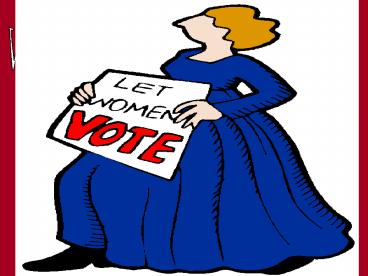Why did the campaign for women's - PowerPoint PPT Presentation
1 / 15
Title:
Why did the campaign for women's
Description:
Generally historians agree that the it was in the 1850s and 60s that first wave feminism emerged. Groups of women (mainly upper and middle class women) began to ... – PowerPoint PPT presentation
Number of Views:335
Avg rating:3.0/5.0
Title: Why did the campaign for women's
1
Why did the campaign for women's suffrage begin
in the 1860s?
2
Generally historians agree that the it was in the
1850s and 60s that first wave feminism emerged.
Groups of women (mainly upper and middle class
women) began to rebel against their exclusion
from the public sphere and to campaign for
greater equality with men.
3
We can see the origins of this movement in a
number of areas.
I realise that the ideas in my book A
Vindication of the Rights of Women will shock
many people. However, I believe that I have only
written the truth to which the majority are blind
that women deserve equal rights as men. Unless
that is so then they will be wasted creatures in
this world.
MARY WOLLSTONECRAFT.
4
Radical male speakers such as Henry Hunt, were
amongst the first to champion the campaign for
womens rights.
1832 REFORM ACT. I put it to Parliament
to include the following amendment in their 1832
Reform Act Women should be entitled to the
vote on the same terms as men.
5
Similarly, women had been actively involved in
the Chartist movements of the 1840s and 1850s.
This was a movement that tried to extend the
right to vote to wider sectors of the
population. However, these women were principally
concerned with campaigning for universal male
suffrage as it was hoped that this would benefit
the family as a whole. Gaining the vote might
bring improvements in pay and working conditions,
which would improve general lifestyles.
6
So, why was it that in the 1850s and 60s we can
really see the feminist movement taking shape as
a campaign and enjoying far more discussion on
the political agenda?
7
The work of groups such as the Ladies of Langham
Place.
WHY THE 1860s??
Improved educational opportunities for women.
Support from influential male politicians.
Many female campaigners came from nonconformist
backgrounds that encouraged reform. They also
had links with radical politicians.
Women were encouraged to push for change
following the increased extension of the male
franchise.
8
There were increased educational opportunities
for women, especially the upper and middle
classes.
This created a new and growing group of women who
felt increasingly frustrated with the
inequalities they faced. They had the motivation
and the skills to effect change.
9
The background of many female campaigners had
been nonconformist eg. Quaker or Unitarian.
These religions encouraged reform and were
closely linked with the radical wing of the
Liberal Party. For example, Millicent Fawcett
(future leader of the suffragist movement) was
married to the Liberal minister Henry Fawcett.
10
We know that there were significant reforms in
womens lives during the years 1850-80. Much of
this work was pioneered by women associated with
the Langham Place Group. They achieved
breakthroughs in the following areas education
local government the medical profession and
sexual morality. Different women would focus on
improving a single issue.
The group developed out of Barbara Leigh Smiths
campaign for married womens property rights and
met here, at Langham Place in London.
11
The Ladies of Langham Place also benefited from
the support of a number of male politicians. It
was through sympathisers such as John Stuart Mill
and Jacob Bright that the issue of female
suffrage was launched and re-launched onto the
parliamentary agenda.
John Stuart Mill proposed an amendment to the
Parliamentary Reform Bill of 1867 which would
have granted the vote to women on equal terms as
men had it been accepted. He also published The
Subjection of Women in 1869 which said that women
could not rely on male voters to represent their
interests. This had to be done by women
themselves from within Parliament.
12
In 1832 the First Reform Act had granted the vote
to middle-class male property owners. During the
years of the Chartist campaigns this remained the
case.
13
By the mid 1860s the political situation was
shifting. In 1866 GLADSTONE introduced a bill to
extend the franchise to a limited number of
working class men. He failed due to resistance
within his own party.
In 1867 a leading Conservative, DISRAELI, again
tried to reform the voting system. The issue had
been truly reopened.
14
Women were now encouraged to place their own
demands for voting rights. When male
householders in the countryside were granted the
vote in 1884, this spurred them on even more!
If male householders can vote, why not female
householders? If working class men can vote, why
not the female teachers who taught them how to
fill in their ballot forms? If farm labourers,
why not the farming widows who employed them?
15
THIS IS THE COMBINATION OF SOCIAL AND POLITICAL
FACTORS THAT LED TO THE EMERGENCE OF THE FEMALE
SUFFRAGE CAMPAIGN IN THE 1860s.































